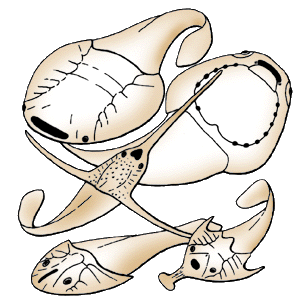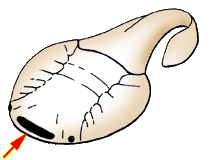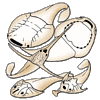Galeaspida
Philippe Janvier



This tree diagram shows the relationships between several groups of organisms.
The root of the current tree connects the organisms featured in this tree to their containing group and the rest of the Tree of Life. The basal branching point in the tree represents the ancestor of the other groups in the tree. This ancestor diversified over time into several descendent subgroups, which are represented as internal nodes and terminal taxa to the right.

You can click on the root to travel down the Tree of Life all the way to the root of all Life, and you can click on the names of descendent subgroups to travel up the Tree of Life all the way to individual species.
For more information on ToL tree formatting, please see Interpreting the Tree or Classification. To learn more about phylogenetic trees, please visit our Phylogenetic Biology pages.
close boxThe main characteristics supporting the nodes of this phylogeny are:
- Node 1: narrower median dorsal opening. Orbits dorsally placed.
- Node 2: only one dorsal, transversal commissural sensory-line canal.
- Node 3: More than ten and up to 45 gill openings and gill units.
Introduction
The Galeaspida, or galeaspids, are a highly diversified group of fossil, armored, jawless vertebrates, which lived in Silurian and Devonian times (430 to 370 million years ago). The head of galeaspids is a massive endo- and exoskeletal shield, which is generally oval or horseshoe-shaped, but can be produced into large rostral and lateral processes. The mouth and gill openings are situated on the ventral side of the head, which is flat and suggests that they were bottom-dwellers (as are the Osteostraci) The body is covered with minute scales, and there is no other fin than the caudal fin. The most peculiar feature of galeaspids is a large, median dorsal opening in the headshield, which communicates ventrally with the pharynx and gill chamber. It is assumed to have served both the olfaction and the intake of the respiratory water, like the nasopharyngeal duct of hagfishes (see Hyperotreti). Galeaspids are the vertebrates which have the largest number of gills, as some species had up to 45 gill openings.
Galeaspids are known exclusively in the Silurian and Devonian rocks of China (including Tibet) and northern Vietnam, and are likely to have been endemic to these areas. They lived in shallow water, deltaic and lagoonal marine environments, and are most diverse in the Lower Devonian (-400 million years ago).
Characteristics
Galeaspids are characterised by:
- A large, dorsally placed median opening in the headshield.
- The scallopped pattern of the dorsal sensory-line canals of the headshield.
Galeaspids somewhat resemble the Osteostraci in having a massive headshield, in which both the endo- and exoskeleton are ossified. The endoskeletal skull is a single mass of cartilage lined with a thin layer of perichondral bone and calcified cartilage. The exoskeleton contains no dentine and is made up by a thick layer of acellular bone (aspidine), as in anaspids. The tubercles of the dermal ornamentation are capped with an enamel-like tissue. The body is covered with minute scales arranged in oblique rows. Galeaspids possess no paired fins and no dorsal and anal fins. The caudal fin is poorly known, but seems to have been pad-shaped or slightly hypocercal, as in the Thelodonti.
The endoskeletal headshield contains cavities and canals for the brain, eyes, labyrinth, nerves, and blood vessels. It is hollowed ventrally by a large cavity, the oralobranchial cavity, which contained the gills and pharynx. The mouth is ventral and opens along the anterior rim of the oralobranchial cavity, and the gill openings along the lateral rim. The oralobranchial cavity is closed by one or two large median dermal plates. Dorsally the oralobranchial cavity opens to the exterior through the median dorsal opening. This opening is currently considered as being chiefly for the intake of the respiratory water, and homologous to the nasopharyngeal duct of hagfishes. However, it also served the olfaction, as the paired olfactory capsules open into it. The nerve canals are still poorly described, but it seems that the foremost gill arch was innervated by the facial nerve.
The brain cavity is quite similar to that of the Osteostraci, with a well-developed, paired recess for the cerebellum. The labyrinth has two vertical semicircular canals, and its is flanked laterally by a large, dorsal jugular vein. The orbits are generally small, and there is a pineal foramen. The sensory-lines are enclosed in very large canals which open to the exterior by a few, large pores.
The highly peculiar shape of the headshield of some galeaspids (with a spatulate rostral process, or very long lateral processes) probably reflects special habits, which are still unknown.
Discussion of Phylogenetic Relationships
There are about seventy species of galeaspids, most of them being distributed into two major clades, the Eugaleaspidiformes and the Polybranchiaspidida ("Polybranchiaspidiformes" , Huananaspidiformes). Some genera, such as Hanyangaspis, Dayongaspis, or Xiushuiaspis are basal galeaspids. The Eugaleaspidiformes and Polybranchiaspidida are sister-groups and share a single, transverse, commissural dorsal sensory-line canal, contrary to these three genera, which have two such canals, like heterostracans and thelodonts (generalized condition).
The Eugaleaspidiformes are characterized by a slit-shaped median dorsal opening and a horseshoe-shaped headshield which mimates that of the Osteostraci. Like basal galeaspids, they have only six to eight gill openings and a corresponding number of branchial fossae which housed the gills.
The Polybranchiaspidida are characterized by a very large number of gill openings and branchial fossae (more than ten and up to 45). They include a number of forms (currently referred to as the "Polybranchiaspidiformes") with an oval headshield, which is probably the general condition for the group, and a clade, the Huannanaspidiformes, characterized by long rostral and lateral processes of the headshield. Such processes, however, also occur in some Eugaleaspidiformes, as homoplasies.
References
Janvier, P. (1984). The relationships of the Osteostraci and Galeaspida. Journal of Vertebrate Paleontology, 4, 344-358.
Janvier, P. (1990). La structure de l'exosquelette des Galéaspides (Vertebrata). Comptes Rendus de l'Académie des Sciences, Paris, 310, 655-659.
Janvier, P. (1996). Early vertebrates. Oxford Monographs in Geology and Geophysics, 33, Oxford University Press, Oxford.
Liu, Y. H. (1965). New Devonian agnathans of Yunnan. Vertebrata PalAsiatica, 9, 125-134. (In Chinese with English summary.)
Liu, Y. H. (1975). Lower Devonian agnathans of Yunnan and Sichuan. Vertebrata PalAsiatica, 13, 215-223. (In Chinese with English summary.)
Pan, J. (1992). New Galeaspids (Agnatha) from the Silurian and Devonian of China. Geological Publishing House, Beijing.
Pan, J. and Chen, L. (1993). (Geraspididae, a new family of polybranchiaspidida (Agnatha), from Silurian of Northern Anhui). Vertebrata PalAsiatica, 31, 225-230. (In Chinese with English summary.)
Tong-Dzuy, T., Janvier, P., Ta Hoa, P. and Doan Nhat, T. (1994). Lower Devonian biostratigraphy and vertebrates of the Tong Vai Valley (Ha Giang Province, Vietnam). Palaeontology, 38, 169-186.
Wang, N. Z. (1991). Two new Silurian galeaspids (Jawless craniates) from Zhejiang province, China, with a discussion of galeaspid-gnathostome relationships.In Early vertebrates and related problems of evolutionary biology (ed. M. M. Chang, Y. H. Liu, and G. R. Zhang), pp. 41-65. Science Press, Beijing.
Zhu, M. (1992). Two new eugaleaspids, with a discussion on eugaleaspid phylogeny. Vertebrata PalAsiatica, 30, 169-184. (In Chinese with English summary.)
Title Illustrations

| Scientific Name | Hanyangaspis, Lungmenshanaspis, Sanchaspis, Eugaleaspis |
|---|---|
| Location | China and Vietnam |
| Comments | Galeaspids are known from the Silurian and Devonian of China and Vietnam. They are characterized by a large, median dorsal inhalent opening and a scallopped pattern of the sensory-lines. Their mouth and gill openings are situated on the ventral surface of the head (top right). In the most primitive forms, such as the Silurian genus Hanyangaspis (top), the median dorsal inhalent opening is broad and situated anteriorly. In other galeaspids, its is more posterior in position and can be oval, rounded, heart-shaped or slit-shaped. In some Devonian galeaspids, such as the hunanaspidiforms Lungmenshanaspis (middle) and Sanchaspis (bottom right), the headshield is produced laterally and anteriorly into slender processes. The eugaleaspidiforms, such as Eugaleaspis (bottom left) have a horseshoe-shaped headshield and a slit-shaped median dorsal opening, which mimates the aspect of the headshield of osteostracans. |
| Reference | Based on Liu, Y. H. (1975). Lower Devonian agnathans of Yunnan and Sichuan. Vertebrata PalAsiatica, 13, 215-223. (In Chinese with English summary.) and Pan, J. (1992). New Galeaspids (Agnatha) from the Silurian and Devonian of China. Geological Publishing House, Beijing. |
| Specimen Condition | Fossil -- Period: Silurian and Devonian |
| Image Use |
 This media file is licensed under the Creative Commons Attribution License - Version 3.0. This media file is licensed under the Creative Commons Attribution License - Version 3.0.
|
| Copyright |
© 1997

|
About This Page

Muséum National d'Histoire Naturelle Paris, France
Page copyright © 1997
 Page: Tree of Life
Galeaspida.
Authored by
Philippe Janvier.
The TEXT of this page is licensed under the
Creative Commons Attribution License - Version 3.0. Note that images and other media
featured on this page are each governed by their own license, and they may or may not be available
for reuse. Click on an image or a media link to access the media data window, which provides the
relevant licensing information. For the general terms and conditions of ToL material reuse and
redistribution, please see the Tree of Life Copyright
Policies.
Page: Tree of Life
Galeaspida.
Authored by
Philippe Janvier.
The TEXT of this page is licensed under the
Creative Commons Attribution License - Version 3.0. Note that images and other media
featured on this page are each governed by their own license, and they may or may not be available
for reuse. Click on an image or a media link to access the media data window, which provides the
relevant licensing information. For the general terms and conditions of ToL material reuse and
redistribution, please see the Tree of Life Copyright
Policies.
Citing this page:
Janvier, Philippe. 1997. Galeaspida. Version 01 January 1997 (under construction). http://tolweb.org/Galeaspida/14839/1997.01.01 in The Tree of Life Web Project, http://tolweb.org/








 Go to quick links
Go to quick search
Go to navigation for this section of the ToL site
Go to detailed links for the ToL site
Go to quick links
Go to quick search
Go to navigation for this section of the ToL site
Go to detailed links for the ToL site